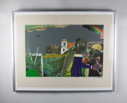Victory Workers
CompletedJan 18, 2024 – Jun 22, 2024
Victory Workers foregrounds twentieth century African American artists who depict Black labor. The exhibition—spanning multiple decades of labor and freedom movements—includes printmaking, painting, sculpture, and photography. From Jacob Lawrence’s lithograph of Black people creating in workshops to Richmond Barthé’s bust of a young Black shoeshine boy, the featured artists amplified the economic, social, and artistic contributions of everyday African Americans. Programs such as the Works Progress Administration (WPA) and Farm Service Administration (FSA) brought the concerns of working-class people to light, as artists documented the effects of the Great Depression. Malvin Gray Johnson used WPA funding to paint rural communities in the South, while Clementine Hunter’s paintings chronicled her life working on the Melrose Plantation near Natchitoches, Louisiana. The heart of their artwork deals with the humanity of working-class people and the lives they lead. They put a face to the often underrecognized labor of African Americans, capturing them with dignity and grace.
Victory Workers includes historical documents and ephemera from the special collections of Xavier University of Louisiana and Tulane University. Archival material situates the work of laborers and artists within the city of New Orleans and reveal the relationships between the people and institutions. Photography, catalogues, scrapbooks, and other print materials make visible the unseen labor of African Americans through the widespread circulation. Local artist Arthur Bedou recorded the activities of influential political figures such as Booker T. Washington and was also a household name for those in New Orleans who wanted their portraits taken. He worked with numerous institutions within the city, including Xavier University of Louisiana, to record craftsmen hard at work, students celebrating their achievements and more. Additionally, these documents emphasize the labor of artists themselves, who often served as educators and collaborators within their respective communities.
Curated by Kendyll Gross
Learn more at the Victory Workers website
Exhibition Objects (1)
Tidings 1980.568
Artists (1)
- Romare Bearden (Charlotte, NC, 1911 – 1988, New York, NY)
el2024.3_victory_worker/victory_worker_JPG/EL2024.3.11.png)

el2024.3_victory_worker/victory_worker_JPG/EL2024.3.9.png)
el2024.3_victory_worker/victory_worker_JPG/EL2024.3.8.png)
el2024.3_victory_worker/victory_worker_JPG/EL2024.3.7.png)
el2024.3_victory_worker/victory_worker_JPG/EL2024.3.6.png)
el2024.3_victory_worker/victory_worker_JPG/EL2024.3.5.png)
el2024.3_victory_worker/victory_worker_JPG/EL2024.3.4.png)
el2024.3_victory_worker/victory_worker_JPG/EL2024.3.3.png)
el2024.3_victory_worker/victory_worker_JPG/EL2024.3.2.png)
el2024.3_victory_worker/victory_worker_JPG/EL2024.3.13.png)
el2024.3_victory_worker/victory_worker_JPG/EL2024.3.12.png)
el2024.3_victory_worker/victory_worker_JPG/EL2024.3.10.png)
el2024.3_victory_worker/victory_worker_JPG/EL2024.3.1.png)